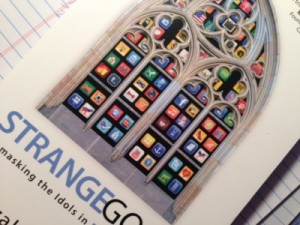Well, this is fun!
The body of Saint Catherine Laboure is displayed in a glass case beneath a side altar in the Chapel of Our Lady of the Miraculous Medal, at 140 Rue de Bac in Paris — the place where she experienced visions of the Blessed Virgin Mary. When the saint’s body was exhumed in 1933, it was found with its eyes open, and they remain open to this day. Pilgrims often comment on the intense shade of blue in Catherine’s eyes.
— excerpted from Saints Preserved; pg 51
Thomas J. Craughwell, the author of Saints Preserved; An Encyclopedia of Relics writes another couple hundred words about Catherine — the events of her life and why she is considered a saint — but I included the excerpt to give you a sense of the conversational accessibility of the book.
 As with his previous Saints Behaving Badly: The Cutthroats, Crooks, Trollops, Con Men, and Devil-Worshippers Who Became Saints, Craughwell has an absolute gift for casual piety; he sees saints as the truly flawed, grace-assisted human beings they were and are, and recommends them to you by serving up the person and their story, wasting no time on the frilly stuff and sometimes-eye-rolling excesses that can haunt Catholic hagiography.
As with his previous Saints Behaving Badly: The Cutthroats, Crooks, Trollops, Con Men, and Devil-Worshippers Who Became Saints, Craughwell has an absolute gift for casual piety; he sees saints as the truly flawed, grace-assisted human beings they were and are, and recommends them to you by serving up the person and their story, wasting no time on the frilly stuff and sometimes-eye-rolling excesses that can haunt Catholic hagiography.
Saints Preserved is not so much a book about the incorruptible bodies of holy men and women. While fascinating, that subject has been pretty comprehensively covered in Joan Carroll Cruz’s The Incorruptibles. Rather Craughwell looks beyond those “first class relics,” broadening his appreciation to the cataloging of a great number of saints, from the internationally famous and revered to those obscure and of localized devotion, what relics of theirs exist, and where they may be found:
Saint Christina (died c. 250) Saint Christina’s relics are kept in Palermo, Sicily, and Torcelli. Her skull is preserved in the Cathedral of Milan.
Saint Christina’s story is a bit confusing. It seems likely that she was a member of the Anicii, one of the noblest Roman families, and that she converted to Christianity while in her teens. A legend tells us that after her baptism she hurried home and smashed every image of a pagan god in her parent’s house.
As the story goes, she was martyred at the Lake Bolsena in Tuscany. Her father tried to drown her by tying a millstone to her neck and throwing her into the deep water, but Christina did not sink. The local magistrate had the girl tied to a tree or a stake and shot to death with arrows.
Saint Christina is the patron saint of archers, millers and sailors. Feast Day: July 24.
I have always been a fan of these sorts of books; I like to keep them scattered about the house — on bedstands or coffee tables, or counters, where they may be picked up and randomly perused, passing on a few interesting nuggets and, occasionally, encouraging a deeper, more intense read.
My only real beef with Saints Preserved has less to do with the book, itself (though I do wish it contained a few more pictures) than with a publishing trend that is wholly due to the rise in e-book sales: the book comes only in paperback, and the pages are rather distressingly pulpy. Given that e-books are outselling material ones, I get it — why waste the money producing a more-expensive paper product, given the decreased demand for same?
I get it, but I don’t have to like it.
I want books. Try as I might, I can’t get into the e-reader thing. You cannot crack open an e-book and take a sniff of the ink. You can’t line them up on a bookshelf and revel in the look of them, the collection of titles. Maybe no one else needs that, but I do.
My husband, on the other hand, would be fine with our library and wallspace being freed up for, oh, I don’t know — a bigger screened tv — but I like books. I want books. Pulpy pages do not make me feel like the book will be with me, mine, all mine, forever.
Still, as I say, this is a preferential rant, and beyond the paperback-only-and-pulpy-pages issue, Saints Preserved is perhaps the most comprehensive look at Holy Relics — of both fact and legend — in the modern era. Craughwell’s exhaustive catalogue extends through the Eastern and Roman churches to include items referenced in scripture; it relates their histories and known locations, and provides entertaining yet respectful hagiographies of the men and women whose faithful lives have inspired such reverent interest in all they have left behind.
This is a marvelously-researched resource that should become a classic entry to a seeker’s spiritual library, and yes, I do recommend it!
And yes, you can get it for your e-reader













